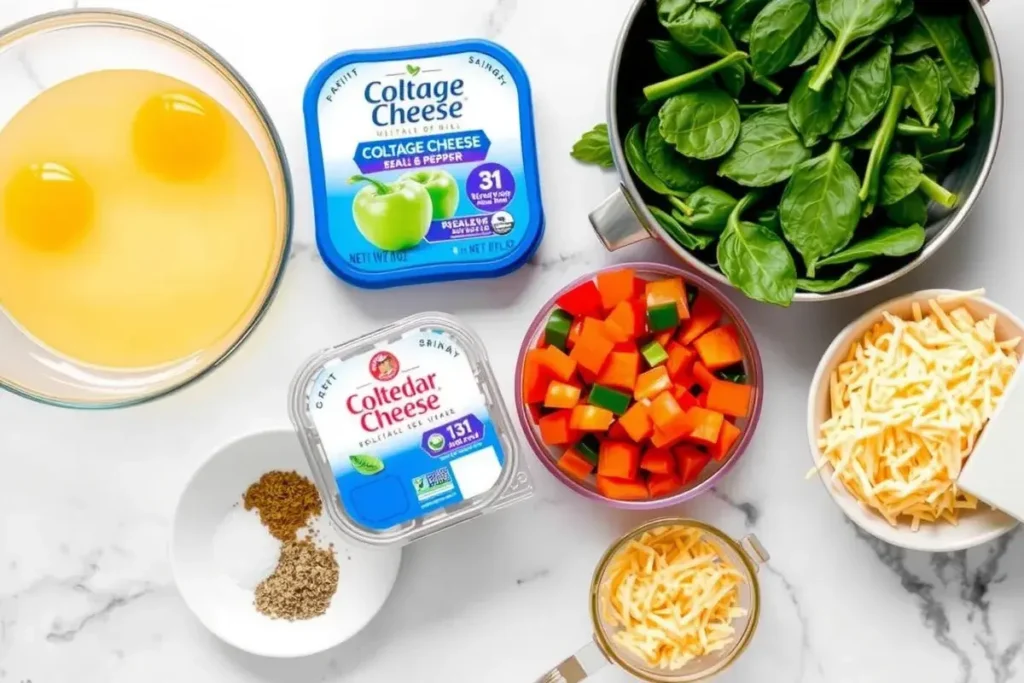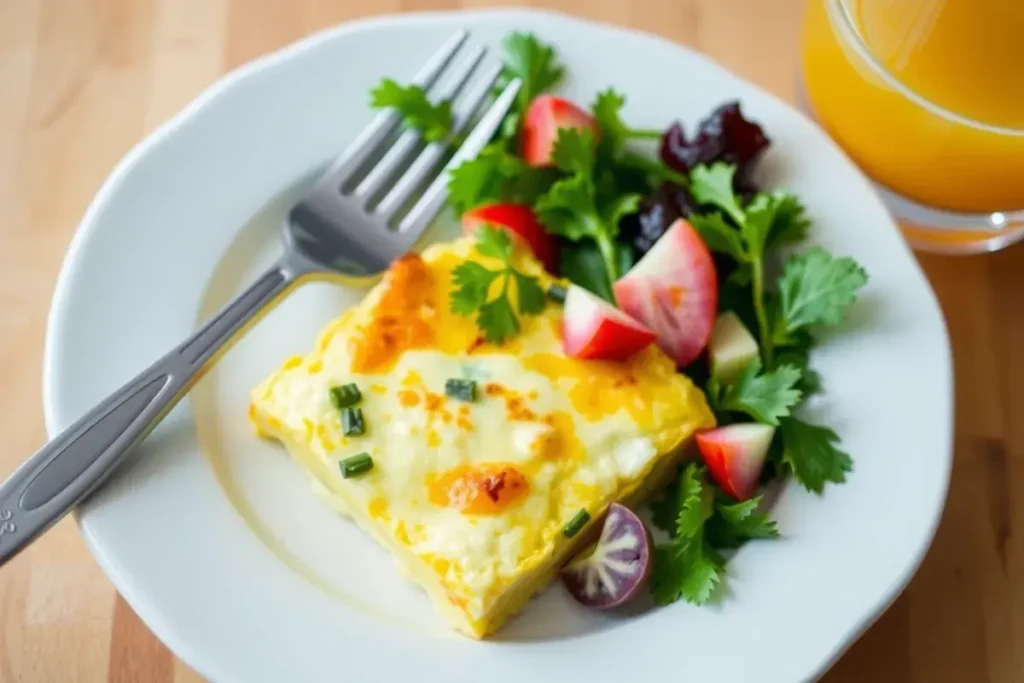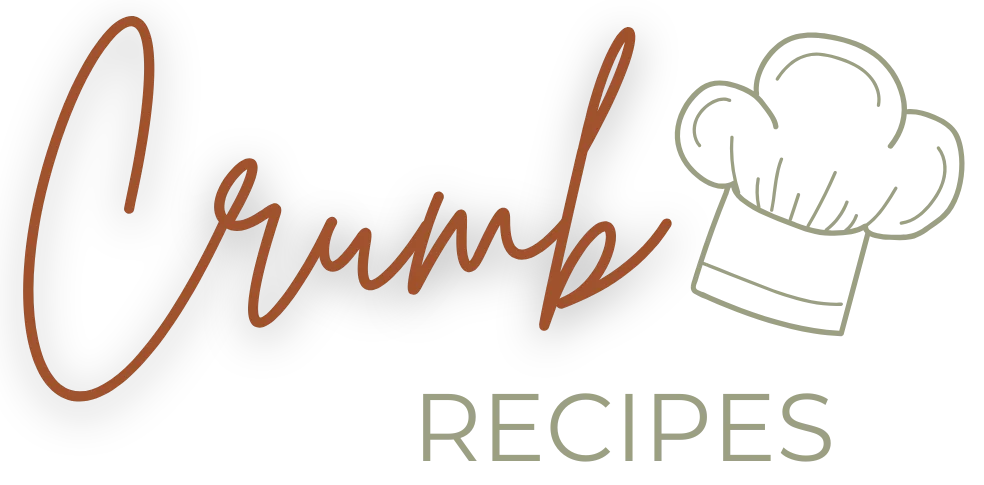A cottage cheese egg bake makes mornings easier, healthier, and more enjoyable. This simple yet flavor-packed dish combines fluffy eggs, creamy cottage cheese, and your choice of wholesome ingredients. Whether you want a protein-rich start to your day, a versatile brunch dish, or a quick meal-prep staple, cottage cheese egg bake can do it all.
In this comprehensive guide, we’ll explore the art of baking eggs with cottage cheese, the history of this popular dish, essential cooking methods, flavor variations, common mistakes, and more. We’ll also provide answers to popular questions about cottage cheese egg bake to help you perfect every batch. By the end, you’ll have the skills needed to whip up this nutritious recipe for yourself, your family, or your guests.
Why Cottage Cheese Egg Bake Has Gained Popularity
The modern appetite for healthy but hearty dishes has fueled the popularity of cottage cheese egg bake. More home cooks than ever are looking for ways to enjoy a satisfying breakfast while juggling busy lifestyles. This baked dish solves many problems:
- Convenience: You can bake it once and eat it throughout the week.
- High Protein: Eggs and cottage cheese unite to deliver muscle-supporting nutrients.
- Low Carb: Many find it suitable for low-carb or keto diets.
- Versatility: You can tweak the recipe with veggies, meats, and cheeses you enjoy.
Modern dietary trends, like low-carb or high-protein regimens, put cottage cheese egg bake in the spotlight. However, it still attracts those who simply crave comfort food with a healthy twist. Therefore, whether you need a grab-and-go breakfast or a family-friendly brunch, cottage cheese egg bake excels as a stress-free solution.
Moreover, the mild flavor of cottage cheese adapts effortlessly to a wide array of seasonings. You can easily transform your bake from a classic spinach-and-cheese combo to a spicy chorizo extravaganza. This flexibility means one recipe can yield multiple flavor experiences.
The Nutritional Benefits of Cottage Cheese Egg Bake
A well-made cottage cheese egg bake offers a range of nutritional benefits that justify its growing popularity. Let’s break down why this dish can be a powerhouse for anyone looking to maintain a balanced diet.
- High-Quality Protein
- Eggs are known for their complete amino acid profile.
- Cottage cheese packs a generous amount of casein protein, which supports muscle repair.
- Together, they create a satisfying and long-lasting energy source.
- Essential Vitamins and Minerals
- Eggs provide vitamins A, D, B12, and more.
- Cottage cheese supplies calcium, phosphorus, and B vitamins.
- Added vegetables can boost fiber, antioxidants, and micronutrients.
- Low-Carb Friendly
- Eggs contain almost no carbohydrates.
- Cottage cheese can be low in carbs if you choose a plain, unsweetened variety.
- Ideal for those following a ketogenic or low-carb lifestyle.
- Moderate Fat Content
- The fat from eggs and cottage cheese can help with nutrient absorption.
- You can opt for reduced-fat cottage cheese if you want to limit saturated fat.
- Olive oil or avocado oil can replace butter to reduce saturated fat further.
- Calorie Control
- Baked dishes often let you portion out servings in advance.
- Pairing with fresh salad or fruit helps balance the meal.
However, nutritional content can vary based on add-ins like cheese, bacon, or sausage. Therefore, be mindful of portion sizes and your choice of ingredients. With a strategic approach, cottage cheese egg bake fits seamlessly into many eating plans.
Essential Ingredients for Your Cottage Cheese Egg Bake

Crafting the perfect cottage cheese egg bake starts with selecting high-quality components. While the specifics may vary depending on the recipe, several core items form the backbone of this dish.
1. Eggs
- Quantity: This largely depends on your baking dish size. A typical 9×13 casserole might need 8–10 eggs.
- Quality: Choose free-range or organic if possible for enhanced flavor and nutrition.
- Whisking: Lightly whisk to incorporate air, ensuring a fluffier texture.
2. Cottage Cheese
- Fat Content: Options range from full-fat (4%) to low-fat (2%) or fat-free. Your pick will influence creaminess.
- Texture: Small-curd cottage cheese blends more smoothly, while large-curd varieties add distinct chunks.
- Flavor Pairing: Cottage cheese has a mild tang that enhances eggs without overpowering them.
3. Vegetables
- Popular Choices: Spinach, bell peppers, onions, mushrooms, or tomatoes.
- Preparation: Lightly sauté watery vegetables (like mushrooms or spinach) to reduce excess moisture.
- Taste Boost: Vegetables introduce color, crunch, and extra nutrients.
4. Additional Proteins
- Bacon or Sausage: Pre-cook to remove some fat. Crumble before mixing.
- Ham or Chicken: Dice cooked ham or shredded chicken for easy integration.
- Plant-Based Options: Chickpeas, beans, or tofu can substitute meat if you prefer a vegetarian version.
5. Seasonings
- Basic Spices: Salt, pepper, garlic powder, onion powder.
- Herbs: Try basil, oregano, parsley, or rosemary.
- Bold Flavors: Chili flakes, paprika, or Cajun seasoning if you want a kick.
6. Cheese Toppings (Optional)
- Shredded Cheddar: Melts well and offers classic breakfast flavor.
- Mozzarella: Mild and stretchy if you like a gooey top.
- Feta: Crumbled feta provides tangy depth.
However, feel free to experiment. Therefore, if you crave a Mediterranean twist, toss in sun-dried tomatoes and olives. For a Tex-Mex approach, add jalapeños and taco seasoning. The limitless possibilities highlight why cottage cheese egg bake remains a staple in so many kitchens.
Selecting the Right Tools and Equipment
A successful cottage cheese egg bake depends partly on having the right gear. Fortunately, you don’t need anything too fancy—just a few basics.
- Mixing Bowls
- A large bowl helps you whisk eggs and cottage cheese together.
- A separate bowl can hold sautéed veggies or cooked meats before combining.
- Whisk or Fork
- Choose a sturdy whisk to incorporate air into the eggs.
- A fork works if you are in a pinch, but a whisk provides more thorough blending.
- Casserole Dish
- A 9×13-inch baking dish accommodates around 8–10 eggs plus add-ins.
- Glass, ceramic, or enameled options distribute heat evenly.
- Non-stick surfaces simplify serving and cleanup.
- Measuring Cups and Spoons
- These ensure consistent seasoning and ingredient ratios.
- Baking success often hinges on accurate measurements.
- Spatula or Wooden Spoon
- Useful for combining the egg mixture with vegetables, meats, and seasonings.
- A silicone spatula can withstand hot pans if you sauté your vegetables first.
- Oven Thermometer (Optional)
- Ovens can vary in temperature by as much as 25°F.
- Confirm your oven’s accuracy for consistent results.
However, you don’t need expensive gadgets. Therefore, with a proper dish, a whisk, and a reliable oven, you can produce a mouthwatering cottage cheese egg bake anytime. This simplicity contributes to the recipe’s enduring popularity among busy families, college students, and meal-preppers.
How to Assemble Your Cottage Cheese Egg Bake
Let’s move on to the actual cooking process. By following these straightforward steps, you’ll create a savory dish that’s fluffy, balanced, and perfect for breakfast or brunch. The entire process can be completed in under an hour, making it ideal for weekday mornings or weekend gatherings.
1: Preheat Your Oven
- Temperature: Aim for 350°F (175°C).
- Timing: Preheat while you prep other ingredients, usually taking about 10–15 minutes.
2: Prep Ingredients
- Beat Eggs: Crack them into a large bowl. Whisk until yolks and whites blend.
- Combine Cottage Cheese: Stir in cottage cheese to distribute curds evenly.
- Season: Sprinkle salt, pepper, and any desired herbs or spices.
- Cook Meats: If you’re using bacon, sausage, or other proteins, cook them fully first. Drain excess fat.
3: Sauté or Pre-Cook Vegetables (Optional)
- Moisture Control: Vegetables like spinach or mushrooms release water.
- Quick Sauté: Heat oil in a pan. Cook veggies for 3–5 minutes. Let them cool slightly before mixing.
4: Combine and Pour
- Fold in Vegetables and Proteins: Use a spatula to gently mix them into the egg-cottage cheese blend.
- Grease Your Dish: Lightly coat your baking dish with cooking spray or butter.
- Pour Mixture: Aim for an even distribution of solids and liquids.
5: Bake
- Position: Place the dish on the middle rack.
- Time: Bake for 25–35 minutes, depending on the thickness.
- Check Doneness: Insert a toothpick or knife in the center. It should come out clean or with minimal moisture.
6: Finish and Serve
- Cooling: Let the bake rest for 5 minutes to set.
- Slice: Cut into squares, rectangles, or wedges.
- Garnish: Sprinkle shredded cheese or fresh herbs on top if desired.
Therefore, the entire method is simple enough for beginners. However, keep an eye on cooking times, especially if you add many vegetables or use a smaller baking dish. Overcooking can cause dryness, while undercooking leaves the center runny.
Popular Variations on Cottage Cheese Egg Bake
One of the greatest strengths of cottage cheese egg bake lies in its adaptability. Whether you crave comfort food or want to embrace global flavors, this dish can shift to meet your culinary desires. Below are some fun and tasty variations.
1. Spinach and Feta Cottage Cheese Egg Bake
- Key Ingredients: Crumbled feta, sautéed spinach, onions, garlic.
- Flavor Profile: Mediterranean flair.
- Serving Idea: Pair with roasted tomatoes for a bright contrast.
2. Bacon, Cheddar, and Chive Cottage Cheese Egg Bake
- Key Ingredients: Cooked bacon pieces, shredded cheddar, fresh chives.
- Flavor Profile: Classic American breakfast.
- Serving Idea: Serve with toast or bagels for a hearty start.
3. Veggie-Packed Egg Bake with Cottage Cheese
- Key Ingredients: Zucchini, mushrooms, spinach, bell peppers.
- Flavor Profile: Fresh, garden-inspired.
- Serving Idea: Garnish with a dollop of plain Greek yogurt and fresh salsa.
4. Spicy Southwest Cottage Cheese Egg Casserole
- Key Ingredients: Taco seasoning, diced chilies, jalapeños, pepper jack cheese.
- Flavor Profile: Bold, slightly spicy.
- Serving Idea: Top with avocado slices and a drizzle of hot sauce.
5. Low-Fat and Low-Calorie Egg Bake
- Key Ingredients: Egg whites, low-fat cottage cheese, veggies of choice.
- Flavor Profile: Lean and clean.
- Serving Idea: A side salad with a light vinaigrette complements the bake well.
However, these suggestions barely scratch the surface. Therefore, don’t hesitate to experiment with leftover roasted vegetables, different cheeses, or unique spice blends. A single base recipe can morph into countless creative renditions.
Common Mistakes to Avoid When Making Cottage Cheese Egg Bake
Even with a straightforward recipe, mistakes can happen. Understanding and avoiding these pitfalls will help you consistently produce a delicious cottage cheese egg bake.
1: Overcooking
- Result: Rubber-like texture and a dry interior.
- Solution: Begin testing doneness at the 25-minute mark. Remove from the oven once the center is just set.
2: Too Much Liquid
- Result: A watery or soggy egg bake.
- Solution: Sauté high-moisture vegetables first. Drain excess water from spinach or mushrooms.
3: Underseasoning
- Result: Bland, forgettable taste.
- Solution: Season each component, especially the egg mix, to ensure a savory bite.
4: Incorrect Oven Temperature
- Result: Uneven cooking or partial rawness in the middle.
- Solution: Preheat thoroughly. Use an oven thermometer to verify accuracy.
5: Skipping the Rest Period
- Result: Runny slices that fall apart on your plate.
- Solution: Let the bake rest for 5–10 minutes so it sets firmly.
6: Improper Tools
- Result: Sticking or uneven heat distribution.
- Solution: Use a quality casserole dish or ovenproof skillet that conducts heat consistently.
Therefore, a little care goes a long way. However, once you figure out the right technique and timing, cottage cheese egg bake becomes nearly foolproof.
Storing, Reheating, and Freezing Your Cottage Cheese Egg Bake

One of the major perks of cottage cheese egg bake is its suitability for meal prep. You can cook it in larger batches, store portions, and enjoy it later with minimal effort.
1. Refrigeration
- How Long: Store leftover slices in airtight containers for up to four days.
- Reheating: Microwave each portion for 60–90 seconds or warm them in a preheated oven at 300°F (150°C).
2. Freezing
- Method: Cut the bake into individual servings. Wrap each piece tightly in plastic wrap or foil.
- Duration: Freeze for up to two months.
- Defrosting: Thaw overnight in the fridge, then reheat thoroughly before eating.
3. Meal Prep Tips
- Portion Control: Slice into consistent squares and label them with the date of preparation.
- Layering: Add sauce or garnish only when you’re ready to eat. This keeps the texture crisp.
- On-the-Go: Transfer slices to a portable container with a fork or napkin for a quick commute-friendly meal.
However, remember that freshly made egg bake typically has the best texture. Therefore, if you plan to serve it to guests, baking it the same morning or evening is ideal. For personal meal-prep though, freezing or refrigerating is highly convenient and timesaving.
Pairing Ideas: What to Serve with Cottage Cheese Egg Bake
Although cottage cheese egg bake stands on its own, complementary sides or condiments elevate the entire meal. Below are some pairing ideas to round out your breakfast, brunch, or even dinner.
- Fresh Fruit Salad
- Balances savory flavors with natural sweetness.
- Strawberries, melons, or grapes work wonderfully.
- Whole-Grain Toast or Muffins
- Adds a satisfying carb element.
- Whole-grain or rye bread provides extra nutrients.
- Side Salad
- Crisp greens, cucumbers, and tomatoes drizzled with a light vinaigrette.
- Refreshes the palate between bites of the egg bake.
- Roasted Potatoes
- Season with rosemary or paprika for a flavorful side.
- Pair well with a hearty, bacon-laden egg bake.
- Smoothies or Juices
- A green smoothie can offer added vitamins.
- Orange or grapefruit juice complements savory dishes.
- Yogurt Parfait
- Layer granola, fresh berries, and Greek yogurt for a protein boost.
- Contrasts the warm richness of cottage cheese egg bake.
However, don’t overcrowd your plate. Therefore, pick one or two sides to keep the meal balanced. This approach also ensures the star of the show—your cottage cheese egg bake—receives well-deserved attention.
FAQ: Common Questions About Cottage Cheese Egg Bake
Why put cottage cheese in eggs?
Cottage cheese adds creaminess and extra protein to eggs. It provides a subtle tang that enhances the flavor profile. Mixing it into scrambled eggs or an egg bake also increases moisture, preventing dryness. Additionally, cottage cheese aids in forming a fluffier texture when baked.
What does cottage cheese do in baking?
Cottage cheese contributes moisture, protein, and creaminess without overwhelming other flavors. It often takes the place of higher-fat ingredients like heavy cream or more cheese. In baked dishes—such as quiches, casseroles, or bread—it keeps the final product tender and soft. Its mild taste also makes it versatile enough to blend well with sweet or savory components.
Why are my cottage cheese eggs watery?
Excess water usually stems from moisture-heavy add-ins. Vegetables like spinach or mushrooms release liquid when cooked. If you skip sautéing or draining them, that fluid ends up in the dish. Additionally, some cottage cheese brands contain more whey, causing higher moisture content. Straining or patting the cheese dry with paper towels can help. Finally, under-baking leaves the center runny, so ensure you cook until the center is just set.
What is the difference between egg bake and frittata?
An egg bake usually involves beating eggs with dairy (like cottage cheese), plus various fillings, and then baking the mixture in the oven. A frittata starts cooking on the stovetop and often finishes under a broiler. Frittatas can be flipped or served directly from a skillet. Moreover, frittatas tend to be thinner, whereas an egg bake might be thicker and more casserole-like. Both dishes rely on eggs as a base, yet cooking techniques and dairy additions set them apart.

